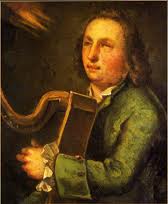Annotation:Grace Nugent: Difference between revisions
No edit summary |
Alan Snyder (talk | contribs) m Fix missing text |
||
| Line 15: | Line 15: | ||
<br> | <br> | ||
</font></p> | </font></p> | ||
<p><font face=" | <p><font face="garamond, serif" size="4"> | ||
''Published sources'': Bunting ('''General Collection of the Ancient Music of Ireland'''), 1796; No. 65, p. 36. '''Complete Collection of Carolan's Irish Tunes''', 1984; No. 110, p. 81. Mulholland ('''Ancient Irish Airs'''), 1810; p. 50. Neal ('''Collection of the Most Celebrated Irish Tunes'''), 1724; p. 26. O'Sullivan ('''Carolan: The Life, Times and Music of an Irish Harper'''), 1958; No. 110, p. 159. | |||
<br> | <br> | ||
<br> | <br> | ||
Revision as of 04:05, 27 March 2015
Back to Grace Nugent
GRACE NUGENT. Irish, Air or Planxty. G Dorian. Standard tuning (fiddle). AB. One of the early compositions of O'Carolan [1] (1670-1738) from the period he was residing with one of his first patrons, George Reynolds Esq., of Letterfyan. The year was 1693, O'Carolan was age 23, and Grace was the first cousin of Squire Reynolds. She was also the fifth and youngest daughter of James Nugent of Castle Nugent, Westmeath, records O'Sullivan (1958), and married her neighbor, Edward Crofton. However, at the time Carolan composed the air Grace was unmarried and living with her siter, Mrs. Conmee (for whom Carolan composed "Elizabeth Nugent"), according to a letter from Charles O'Conor in 1785. The tune was published in Daniel Wright's Arva di Camera, London, 1727. Later in the century the Scottish poet Robert Burns used the tune for his song "Louis, what reck I by Thee?" The Belfast Northern Star of July 15th, 1792, recorded that the tune was played by one of ten harp masters at the last great convocation of ancient Irish harpers, the Belfast Harp Festival, held that week.

The melody, as O'Sullivan points out, is based on the familiar English air "British Grenadiers (The)," which dates to the 16th century and predates Carolan's composition. John Mulholland's version (Ancient Irish Airs, 1810) [2] is nearly identical with Edward Bunting's version in the first strain, but differs somewhat in the second.
Source for notated version: Samuel, Anne and Peter Thompson's Hibernian Muse; a Collection of Irish Airs, including the Most Favourite Compositions of Carolan, the Celebrated Irish Bard (London, c. 1786) [O'Sullivan].
Published sources: Bunting (General Collection of the Ancient Music of Ireland), 1796; No. 65, p. 36. Complete Collection of Carolan's Irish Tunes, 1984; No. 110, p. 81. Mulholland (Ancient Irish Airs), 1810; p. 50. Neal (Collection of the Most Celebrated Irish Tunes), 1724; p. 26. O'Sullivan (Carolan: The Life, Times and Music of an Irish Harper), 1958; No. 110, p. 159.
Recorded sources:
